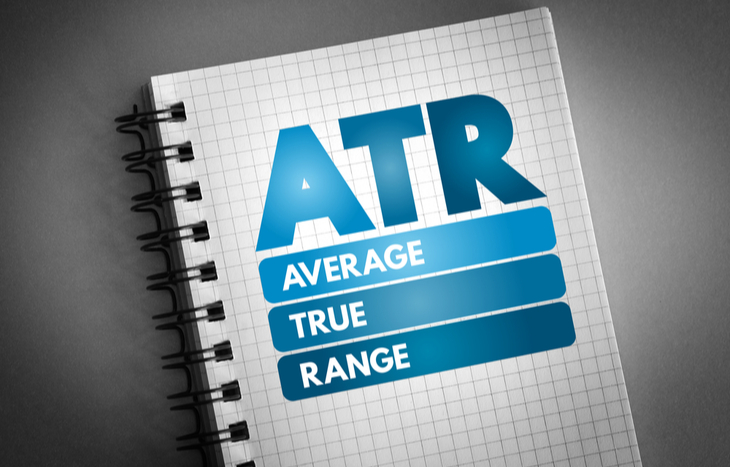What is Average True Range?
In technical analysis, investors use quantifiable metrics to gauge potential stock movements based on behavior. Many of these variables stem from measuring the stock’s volatility. And this includes Average True Range (ATR). This metric looks at recent price movements to determine acceptable floors and ceilings, which then serve as context for pattern recognition and trading.
Average True Range is a very common metric used by institutional investors to provide baseline context for a stock’s performance. By looking at recent highs and lows, investors establish a variance for acceptable price movement. This usually happens over a 14-day trading period. For example, if the ATR of a stock is $2.50, it wouldn’t be unusual for that stock to gain or lose up to that much during a single trading period.
ATR is an extremely useful metric not only by itself, but in conjunction with other forms of technical analysis. For traders, it’s especially useful as a measure of expected volatility. Here’s how it works.

ATR is a Measure of Volatility
Many institutional traders use ATR as a pure measurement of volatility. The two are, in many cases, synonymous. ATR shows investors the limits of how much they can reasonably expect a stock to move each day, which is tantamount to its volatility.
ATR is an ongoing metric that needs reconstituting daily. This is the case even if there isn’t a new high or low. This is because each new trading period provides price action that factors into the overall volatility of the stock. Stocks that see less deviation from the mean will also see their ATR shrink. Conversely, stocks with a lot of up and down action will see their ATR climb higher, indicating more volatility.
The Formula for Average True Range
Almost every trading platform has some form of ATR calculator or the ability to overlay Average True Range atop the stock chart. Nevertheless, technical traders should also know how to calculate it manually. The formula is simple:
Average True Range = True Range / 14
To calculate ATR accurately, investors first need to find the stock’s true range. This is considerably more complex. There are actually three measures that factor into True Range. The current High less the current Low, less the previous Close (absolute value) and less the previous Close (absolute value).
Once you know the average of these figures, you can factor them into calculating ATR. That figure is divided by the 14-day period to provide the ATR: the measure of accepted volatility.
Again, it’s much quicker and easier to simply plug a stock ticker into a web calculator or to use the overlays for ATR provided by your brokerage. Not only are they quicker, they’re dynamic. Remember, to get an accurate depiction of ATR, you need to recalculate it every period to account for the latest dataset.
Comparing Stocks with ATR Percentage
Average True Range is a great evaluation metric for looking at a stock’s volatility. But it can also shed light on how volatile a stock is in comparison to another. To do this, investors reconstitute ATR as a percentage. A percentage that’s easily compared against the ATR percentage of any other stock.
To calculate ATR as a percentage, simply divide the stock’s ATR by its current price. This percentage allows investors to compare stocks side by side. It allows them to measure their volatility even in spite of price differences. For example, a stock priced at $50 with an ATR of 3% would be a more stable investment than a stock priced at $90 with an ATR of 9%. It’s a quick way to qualify the price movements of a stock across different prospective positions.
How to Use ATR When Stock Trading
Average True Range is most commonly used to benchmark entry and exit positions from trades, especially those following a pattern. Most often, it’s an exit indicator. For example, a trader might place a trailing stop that moves in tandem with the changing ATR. They would do this as a way to protect themselves from volatility, while also tracking it. A trailing stop that tracks ATR also safeguards trades from general market movement.
Using ATR as a forward-looking tool is also advantageous to investors. Applied ahead, ATR can show potential buy points based on stock behavior. It’s important to realize, however, that ATR doesn’t indicate volatility in any one direction. It’s simply a measure of deviation. A stock might have an ATR of $3 going into a triangle pattern. However, there’s no way of telling which way that potential breakout might occur. Instead, it’s a barometer for where to set stops and limits.
The Drawbacks of Average True Range
As a pure measure of volatility, ATR is subject to some criticism. It only looks at volatility from a historical pricing standpoint. And, as a result, ignores market context. Moreover, broad-market conditions can affect the accuracy of ATR by impacting price outside of the norm.
Again, it’s also important to mention that ATR can’t provide context for trends. Because it measures volatility, the price could go either way when a breakout occurs. A company may have a high ATR and see a massive price upswing. While another company with the same ATR sees its stock price plummet. Average True Range demands context.
A Critical Measure of Stock Volatility
For traders, a clear understanding of volatility is vital when entering positions. And also for capitalizing on a profitable exit. Average True Range is a pure measure of volatility that provides context for potential price movement. Factored into technical analysis, it’s a staple metric used by almost every investor. Get familiar with ATR and its implications. Once you do, you’ll better-understand the risk involved with a particular short-term trade or developing chart trend.
For more insight on the stock market, sign up for the Wealthy Retirement e-letter below. You’ll receive tips and tricks from top market experts. Sign up today!





